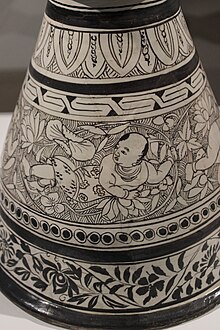Cizhou ware
Cizhou ware or Tz'u-chou ware[1] (Chinese: 磁州窯; pinyin: Cízhōu yáo; Wade–Giles: Tz'u-chou yao) is a wide range of Chinese ceramics from between the late Tang dynasty and the early Ming dynasty,[2] but especially associated with the Northern Song to Yuan period in the 11–14th century.
It has been increasingly realized that a very large number of sites in northern China produced these wares, and their decoration is very variable, but most characteristically uses black and white, in a variety of techniques.
[3] Alone among major types of Song ceramics their effect largely depends on decoration in contrasting colours, usually in black on white, but sometimes polychrome.
[6] Most Cizhou ware uses a transparent glaze applied on a white slipped-body, with further decoration chosen from a wide variety of techniques.
Other techniques include the shallow carving common on other Song ceramics such as Ding ware and celadon or greenwares, incising, stamping, and working with a roulette or tool with a ridged wheel.
Human figures may be used, and especially in the large flat space offered by the top of a head-rest, there are sometimes several together, set in a landscape and perhaps showing a scene from literature or legend.
[13] There are often painted inscriptions, typically related to drinking on appropriate pieces, wishing good sleep on head-rests, or short poems.
[28] Although strongly based in the north, some Cizhou-type wares were produced in the south, and the products were very widely distributed across China, even if little was exported.
[31] In their emphasis on painted decoration, whether under or over the glaze, Cizhou ware anticipated the style that would, eventually, come to dominate Chinese ceramics, even those for the court.
The Mongols often forced artists to move locations, and this period saw the beginning of underglaze painted blue and white porcelain from Jingdezhen.




